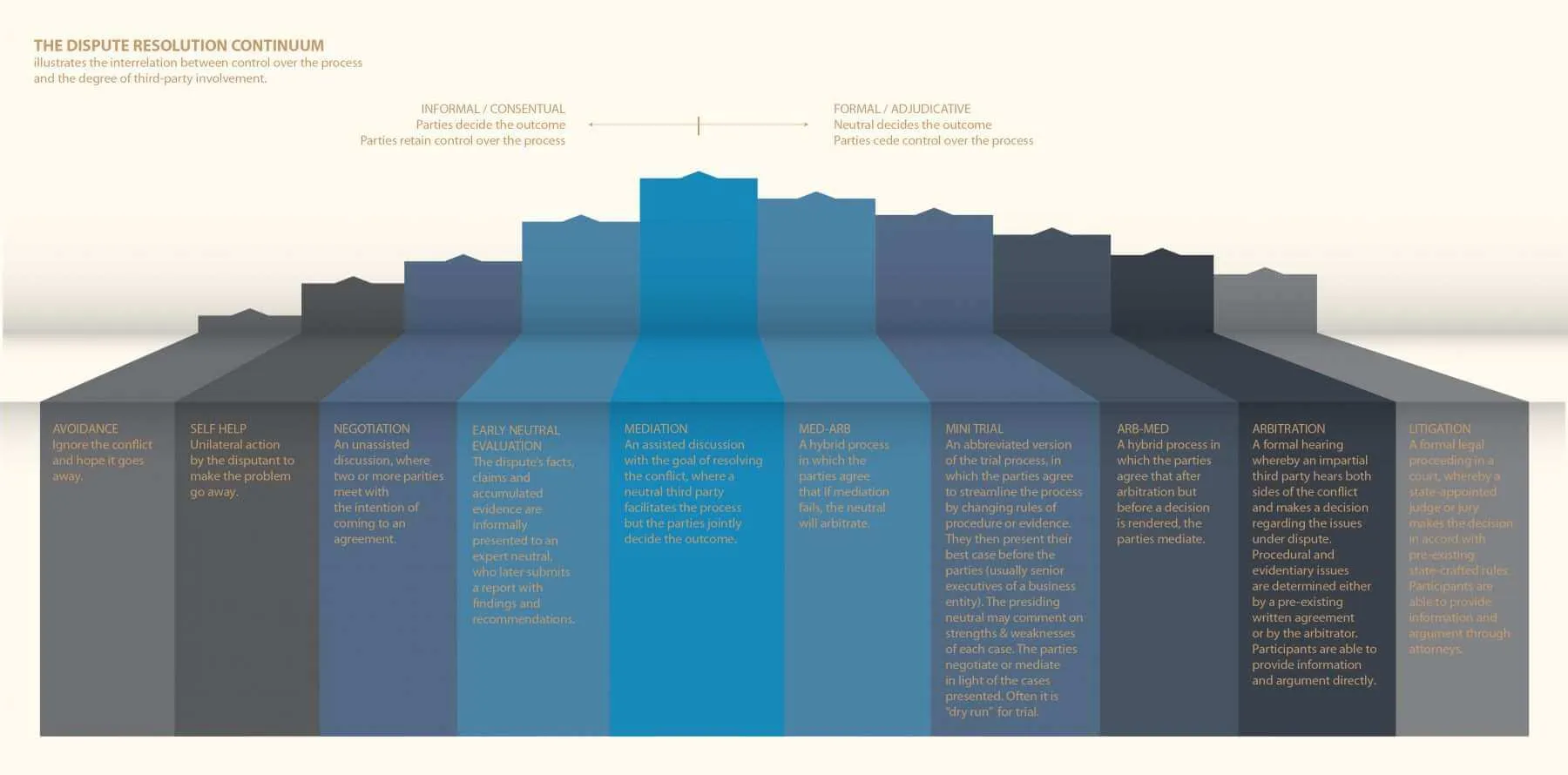
We are all involved in conflicts every day, ranging from when our kids are going to bed or what movie to see. Our conflicts highlight our needs and desires and reflect those of others. To be conflict-free is to be isolated.
Of course conflict outcomes matter, but our methods of resolution do too. What method we use is an important choice that should be thoughtfully made. While some methods are usually right and others often wrong. It isn’t hard to think of a situation in which some other choice is better, no matter which method one chooses. Context is king.
This is behind Sander and Goldberg’s advice to “fit the forum to the fuss” when choosing a resolution method.
The graphic above illustrates the “Dispute Resolution Continuum.” It is meant to illustrate the interrelation between control over the process and the degree of third-party involvement.
Above is a graphical continuum of some options available and a brief description of each.
Arranged in order along horizontal bar:
Avoidance
Ignore the conflict and hope it goes away.
Self-help
Unilateral action by the disputant to make the problem go away.
Negotiation
Unassisted discussion, where two or more parties meet with the intention of coming to an agreement.
Early Neutral Evaluation
The dispute’s facts, claims, and accumulated evidence is informally presented to an expert neutral, who later submits a report with findings and recommendations.
Mediation
An assisted discussion with the goal of resolving the conflict, where a neutral third party facilitates the process but the parties jointly decide the outcome.
Med–Arb
A hybrid process in which the parties agree that if mediation fails, the neutral will arbitrate.
Mini-Trial
An abbreviated version of the trial process, in which the parties agree to streamline the process by changing rules of procedure or evidence. They then present their best case before the parties (usually senior executives of a business entity). The presiding neutral may comment on strengths and weaknesses of each case. The parties negotiate or mediate in light of the cases presented. Often it is a “dry run” for trial.
Arb-Med
A hybrid process in which the parties agree that after arbitration but before a decision is rendered, the parties mediate.
Arbitration
A formal hearing whereby an impartial third party hears both sides of the conflict and makes a decision regarding the issues under dispute. Procedural and evidentiary issues are determined either by a pre-existing written agreement or by the arbitrator. Participants are able to provide information and argument directly.
Litigation
A formal legal proceeding in a court, whereby a state-appointed judge or jury makes the decision in accord with pre-existing state-crafted rules. Participants are able to provide information and argument through attorneys.
The relevant variables in choosing a process are numerous: personal involvement, control, involvement of others, formality, complexity, average duration, cost, and confidentiality. A process place along the line will change slightly depending on which of these is one’s focus. But in general, as party control drops, the other variables rise.
The list is not exhaustive. Alternative dispute resolution evolves daily, and the parties are largely free to craft their own processes. What this means for you as a disputant is that you are free to choose the place along the line that fits you best, provided you can get your co-disputant to agree.
Must-read Articles:
- Understanding the Stages of Conflict: A Guide - July 23, 2024
- What Is Dehumanization? An In-Depth Overview - July 12, 2024
- Can Text Messages be Used in Court? A Close Look - July 11, 2024


